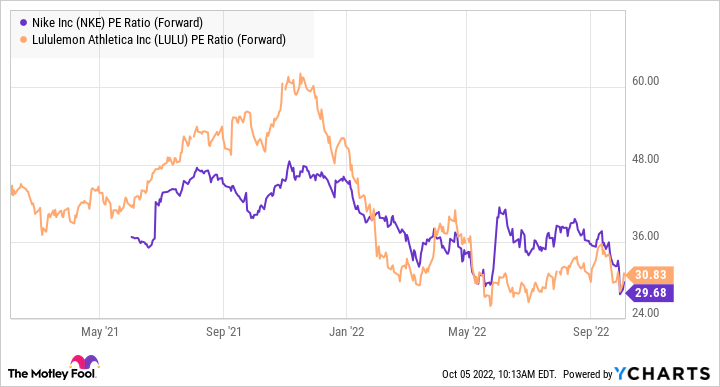Shares of Nike (NKE 0.34%) are down 52% since hitting an all-time high toward the end of last year. Weak results from major retailers meant investors had low expectations entering Nike's latest quarterly report, but the swoosh still failed to deliver. Let's see why and what investors should make of it.
Nike reported decent revenue growth for the quarter, but economic headwinds are presenting problems. Profits fell as inflationary costs in transportation and higher reliance on promotional sales and markdowns weighed on margins. The stock tumbled to new lows following the report.
Nike is a fantastic brand. It has one of the world's most iconic logos, and the near-term uncertainty in the economy means investors can buy the stock at a cheaper valuation of 30 times this year's consensus earnings estimate, which is down from over 40 earlier this year.
But before deciding to buy the stock, investors should shop around to see if Nike really offers the best value relative to its underlying business growth.
Comparing Nike stock to alternatives
One way to determine if a stock is undervalued and worth buying is to compare its price-to-earnings (P/E) ratio to the average company in the S&P 500 index.
The S&P 500 index average forward P/E is currently 17. Is Nike worth its higher valuation? On the one hand, its history of consistent growth, brand strength, and secular industry tailwinds justifies it. However, Nike's long-term expectation for mid-to-high teens growth in earnings per share (EPS) compared to the median of 12% EPS growth for the average company in the S&P 500 index makes it difficult to justify paying almost twice as much for each share of Nike on a P/E basis.
Another way to gauge the value of a stock is to compare it to industry peers. Let's look at Lululemon Athletica. Lululemon reported revenue growth of 29% year over year in the most recent quarter, which is blazing fast compared to Nike's 4% in its fiscal first quarter. On a constant-currency basis, Nike is still growing the top line at only 10%.
Lululemon is also doing a better job of holding its profit margin up. It faces the same inflationary costs as other retailers right now, but Lululemon still managed to grow earnings per share 33% year over year in the last quarter. Nike reported a 20% decline in EPS.
Overall, Lululemon has navigated through supply chain issues during the pandemic and inflation far better than the world's largest athletic wear brand.

Data by YCharts.
Analysts expect Lululemon to report full-year revenue growth of 26.7%, with adjusted earnings per share up 27%. Lululemon reported "robust" guest traffic in stores last quarter, in addition to strong growth in e-commerce.
By comparison, analysts expect Nike to report full-year growth for its May-ending fiscal year of less than 5%, on top of a 20% drop in earnings per share. Nike executives also pointed to "strong demand" in the marketplace in the last earnings report, but that description should come with an asterisk since Nike had to rely on promotional sales to drive growth.
Promotional activity is increasing across the marketplace, but Lululemon appears so far to be immune to this since it is positioned as a premium brand and is not known for discounting merchandise.
Nike stock is still too expensive
Despite growing much faster than Nike, Lululemon stock trades at a forward P/E of 30.8, just slightly higher than Nike's 29.7 forward P/E.

Data by YCharts.
Investors are getting substantially more growth with Lululemon for almost the same price. That makes Nike look relatively overvalued compared to its faster-growing industry peer.
Nike's premium to the S&P 500 and relatively low growth compared to Lululemon make it clear that Nike stock is still too expensive and should be avoided right now.





